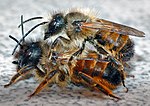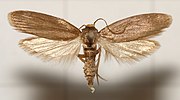 | Mason bee is a name now commonly used for species of bees in the genus Osmia, of the family Megachilidae. Mason bees are named for their habit of using... 14 KB (1,639 words) - 01:20, 24 August 2023 |
 | Colony collapse disorder (redirect from North American bee disappearance of 2007) worker bees in a honey bee colony disappear, leaving behind a queen, plenty of food, and a few nurse bees to care for the remaining immature bees. While... 138 KB (15,458 words) - 13:36, 26 April 2024 |
Diseases of the honey bee or abnormal hive conditions include: Varroa destructor and V. jacobsoni are parasitic mites that feed on the fat bodies of adult... 66 KB (7,646 words) - 10:28, 15 April 2024 |
 | Varroa destructor (redirect from Bee mite) on honey bees and is one of the most damaging honey bee pests in the world. A significant mite infestation leads to the death of a honey bee colony, usually... 38 KB (4,443 words) - 21:14, 27 April 2024 |
 | honey bee (A. m. scutellata) with various European honey bee subspecies such as the Italian honey bee (A. m. ligustica) and the Iberian honey bee (A. m... 56 KB (6,413 words) - 21:50, 1 April 2024 |
 | Waxworm (category Western honey bee pests) In the wild, they live as nest parasites in bee colonies and eat cocoons, pollen, and shed skins of bees, and chew through beeswax, thus the name. Beekeepers... 13 KB (1,495 words) - 12:43, 11 February 2024 |




